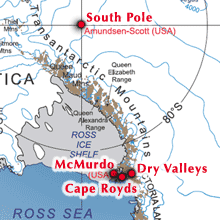Glaciers and the Simple Life in Antarctica’s Dry Valleys
TAYLOR VALLEY, DRY VALLEYS, ANTARCTICA– In this interview from in front of the Canada Glacier in Antarctica’s Taylor Valley, Hassan Basagic from Portland State University describes the essential role of polar glaciers in supporting the bare-bones ecosystems in the Dry Valleys. In addition to studying the Canada Glacier in Antarctica, where a typical field season lasts three months, Hassan has studied glaciers in the Sierra Nevada of California. Polar glaciers in the Dry Valleys are unique among the world’s alpine glaciers in having steep, high faces. Hassan explains that their unique shapes arise because the glaciers are frozen at their base and flow from the top rather than the bottom of the glacier.
Hassan is part of the glaciology team for the McMurdo Dry Valleys Long Term Ecological Research site (LTER for short), which is led by Andrew Fountain of Portland State. The LTER Network includes 26 sites mostly in the US, and includes ecosystems from the poles to the tropics. Scientists study the areas from many angles, combining their research to give a broad view of how ecosystems work. (Video by Lisa Strong-Aufhauser)
Get the Flash Player to see this player.











Mary,
I need to be able to hear the responses to the questions that you ar asking the glaciologists. I can hear you but not other people. Maybe sharing one microphone is not a good thing especially when you don’t get the mike any closer to anyone while they are giving their responses.
Evon,
Please check your audio settings. There are two mics being used in this interview– a wireless lavalier mic for the scientist, and the big fuzzy mic you see Mary using. Both audio channels are included in the video at the same volume– so the scientist’s voice is equal, if not louder, than Mary’s.
Thanks for visiting!
All the best,
Kate O’Donnell
(Ice Stories Project Coordinator)
Hi There,
Great job! I can’t wait to use this with my students. A transcript of the audio would be ideal in order to differentiate the resource. Some students have an easier time pulling information when they can read it, or read along while listening. Just a suggestion.
Thanks!